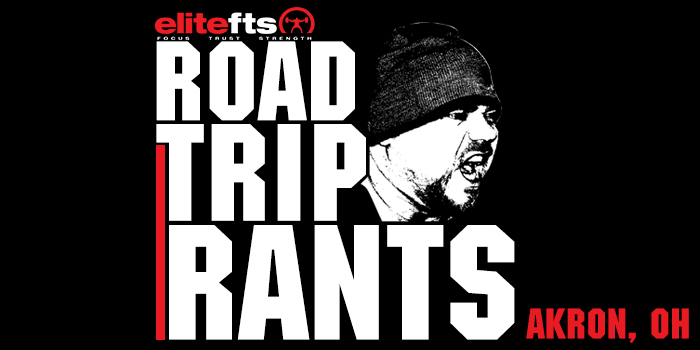
The Table Talk series remains on hold while Dave continues to instead answer training questions from behind the wheel. In this episode of Road Trip Rants, Dave responds to three questions — the first about deadlifting cueing, the second about the best thing currently happening in powerlifting, and the third about low back training with a reverse hyper and 45-degree back raise.
“[What are the best] cues to teach someone how to round their upper back in the deadlift?”
The first thing to recognize is that you don’t actually want to round your upper back. This is a verbal cue but it’s not what you actually want to happen with your body during a deadlift. This is an example of a cue that has been taken too literally, which Dave says he is somewhat responsible for because he, over the years, has shared many verbal cues in articles and on the website that are easily misinterpreted. Instead of rounding the upper back, what you want is to “pack” the shoulders so you aren’t in a shrug position. The deadlift doesn’t end with a high pull. You want to get your shoulders as low as they can possibly be, and “rounding the upper back” is a cue that can be used to get lifters to stop shrugging the bar, but it shouldn’t be turned in a slouch. Cues for accomplishing this include “tucked chin” and telling lifters to drive their traps to the wall, which Dave has been using more recently.
“[What is the] best thing going on in powerlifting right now?”
The biggest positive thing Dave sees in the sport right now is the fact that lifters have taken greater control over it. Lifters today run the sport more than they have in the past, meaning they have taken some control from the meet promoters and federations and companies in the industry. You can see the proof of this in the popularity of raw competition today. Before 2012 or so, very few lifters were competing raw, which goes all the way back to the 70s and 80s when gear started to become more popular and there was no real option other than to wear the gear if you wanted a legitimate shot at competing. The federations at the time and the companies that produced the gear stood to lose a lot of money from the transition away from equipped lifting — but they couldn’t stop it from happening. Raw lifting became popular because that’s what the lifters wanted and that’s what they demanded.
“[What are your] favorite exercises to strengthen the lower back using only the reverse hyper and 45-degree back raise?”
With just those two machines, there are a ton of variations you can perform. The reverse hyper has many options but the best place to start is to perform them two separate ways. The first way is to perform them “tight”, where you only allow your feet to cross the post closest to you before reversing the weight, keeping your back in an arched position. This is a very strict movement and requires you to set up a little further back on the machine. The second way is to perform them “loose”, where you let the weight swing you under until your feet cross the post farthest away from you, using the momentum and heavier weight to focus on squeezing the glutes.
On the 45-degree back raise, you can use straight weight, a variety of barbells, a weight vest, a medicine ball, or any other loading method you can think of. You can also do them with an asymmetric concentric-eccentric loading scheme, where you lift a heavy medicine ball on the way up and then drop it for a lighter eccentric.










